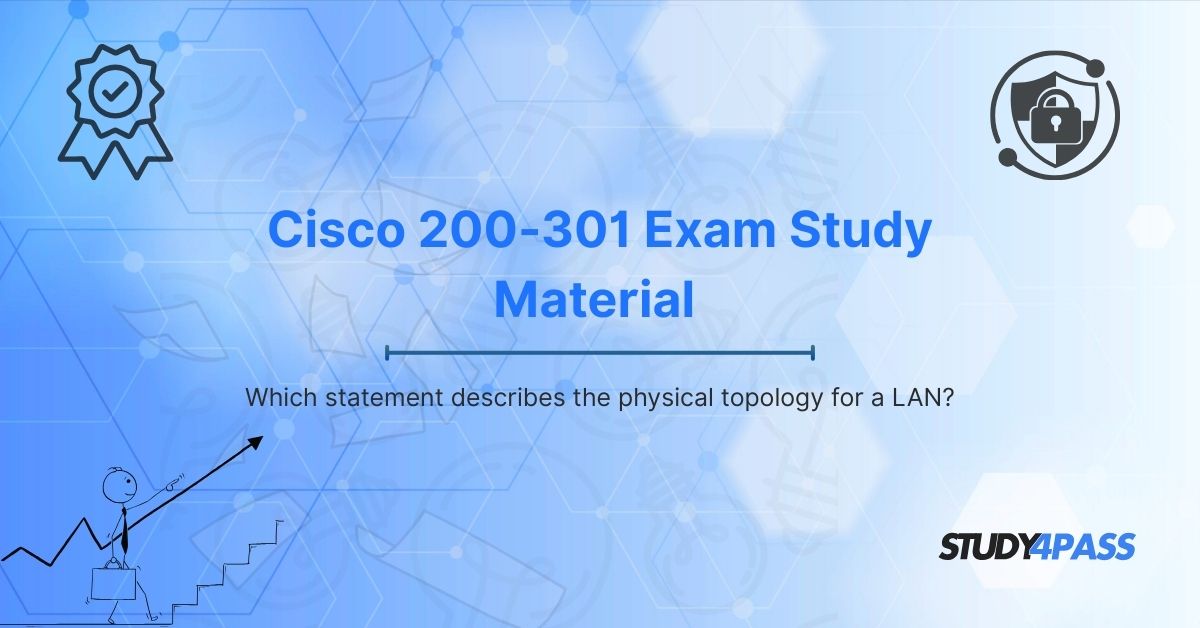Introduction
When preparing for Cisco certification exams like CCNA (200-301), CCDA, CCENT, CCNA Security, and CCNA Wireless, understanding Local Area Network (LAN) topologies is crucial. One common question that arises is: "Which statement describes the physical topology for a LAN?"
This article will explore:
- The definition of physical topology
- Different types of LAN physical topologies
- How they impact network design
- Their relevance in Cisco certification exams
- Why Study4Pass is an excellent resource for exam preparation
By the end of this article, you will have a clear understanding of LAN physical topologies and their significance in networking.
What is Physical Topology in a LAN?
Physical topology refers to the actual layout of devices, cables, and network components in a Local Area Network (LAN). It defines how network elements are physically connected and arranged.
Key Characteristics of Physical Topology:
- Cable Arrangement – How devices are interconnected via cables (Ethernet, fiber optic, etc.).
- Device Placement – The physical positioning of routers, switches, and end devices.
- Scalability & Maintenance – How easy it is to expand or troubleshoot the network.
Unlike logical topology (which deals with data flow), physical topology focuses on hardware connections.
Types of Physical Topologies in a LAN
There are several common physical topologies used in LANs:
1. Bus Topology
- Description: All devices are connected to a single backbone cable (bus).
- Advantages:
- Simple to set up.
- Cost-effective for small networks.
- Disadvantages:
- A single cable failure disrupts the entire network.
- Performance degrades with heavy traffic.
- Example: Early Ethernet networks (10Base2 and 10Base5).
2. Star Topology
- Description: All devices connect to a central hub or switch.
- Advantages:
- Easy to install and manage.
- Failure of one cable does not affect others.
- Disadvantages:
- Dependent on the central device (if the switch fails, the network goes down).
- Example: Modern Ethernet networks (using switches).
3. Ring Topology
- Description: Devices are connected in a closed loop, where each device connects to two others.
- Advantages:
- Equal network access for all devices.
- No collisions (in token ring networks).
- Disadvantages:
- A single break in the ring can disrupt the entire network.
- Example: Token Ring networks (less common today).
4. Mesh Topology
- Description: Every device is connected to every other device.
- Full Mesh: All devices are interconnected (high redundancy).
- Partial Mesh: Only critical devices have multiple connections.
- Advantages:
- Highly fault-tolerant.
- No single point of failure.
- Disadvantages:
- Expensive due to high cabling requirements.
- Example: Enterprise networks, data centers.
5. Hybrid Topology
- Description: A combination of two or more topologies (e.g., star-bus, star-ring).
- Advantages:
- Flexible and scalable.
- Can optimize performance based on needs?
- Disadvantages:
- More complex to design and maintain.
- Example: Large corporate networks.
Which Statement Best Describes LAN Physical Topology?
In the context of Cisco exams (CCNA 200-301, CCENT, etc.), the correct statement describing physical topology for a LAN would be:
"Physical topology refers to the arrangement of cables, network devices, and end systems in a LAN."
This definition emphasizes the physical layout rather than data flow (logical topology).
Why is This Important for Cisco Exams?
- CCNA 200-301 tests knowledge of network fundamentals, including topologies.
- CCENT requires understanding of basic LAN designs.
- CCNA Security & Wireless may involve topology impacts on security and signal distribution.
How Study4Pass Helps in Cisco Exam Preparation?
If you're preparing for Cisco certifications (CCNA, CCDA, CCENT, etc.), Study4Pass is an excellent resource. Here’s why:
1. Comprehensive Study Materials
- Provides detailed notes on LAN topologies, network design, and Cisco technologies.
- Covers exam-specific topics for CCNA 200-301, CCNA Security, and CCNA Wireless.
2. Practice Questions & Mock Tests
- Includes topology-related questions to test understanding.
- Simulates real Cisco exam environments.
3. Expert Guidance
- Offers tips and strategies from certified professionals.
- Clarifies complex topics like physical vs. logical topologies.
4. Updated Content
- Aligns with the latest Cisco exam blueprints.
- Ensures you study relevant and current material.
5. Affordable & Accessible
- High-quality resources at a reasonable price.
- Accessible anytime, helping you study at your own pace.
Conclusion
Understanding physical topology in a LAN is essential for Cisco Certification Exams (CCNA, CCENT, CCDA, etc.). The correct statement describing it is:
"Physical topology refers to the arrangement of cables, devices, and end systems in a LAN."
Different topologies (Bus, Star, Ring, Mesh, Hybrid) have unique advantages and use cases. For effective exam preparation, Study4Pass offers structured study materials, practice tests, and expert guidance, making it a top choice for Cisco aspirants.
By mastering LAN topologies, you’ll be well-prepared for Cisco certification success!
Special Discount: Offer Valid For Limited Time “200-301 Exam Prep Practice Tests PDF”
Actual Exam Questions For Cisco's 200-301 Certification
Sample Questions For Cisco 200-301 Practice Exam
1. What does the physical topology of a LAN refer to?
A) The logical path data follows in a network
B) The way devices are physically connected in a network
C) The software protocols used for communication
D) The security measures applied to a network
2. Which of the following is NOT a type of physical LAN topology?
A) Bus
B) Star
C) Ring
D) Firewall
3. In which physical topology are all devices connected to a central hub or switch?
A) Mesh
B) Star
C) Bus
D) Hybrid
4. What is a disadvantage of a bus topology in a LAN?
A) High cost of cabling
B) If the main cable fails, the entire network goes down
C) Difficult to add new devices
D) Requires a central server for all communications
5. Which physical topology provides the highest redundancy and fault tolerance?
A) Star
B) Ring
C) Mesh
D) Bus


